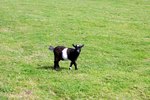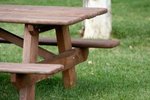
Rose hips give valuable nutrition to squirrels in your yard, especially in the winter. Long before cultivation, roses had a relationship with squirrels. Rose hips, seed pods that turn orange or red below the bloom, give the bushy-tailed chatterers tasty food, rich in vitamin C. In return, squirrels help spread the rose's seeds. The indigestible rose seeds germinate better after passing through their digestive systems. Wild roses, garden roses and squirrel feed containing rose hips continue this mutually beneficial relationship. (See Ref. 1: graph 7 on rose seeds improved germination)
Nature's Web
Many species of squirrels live in a variety of habitats, including western gray squirrels in balmy woodlands in California and eastern squirrels in snow-laden forests in Canada. In some areas, such as the Rocky Mountains, squirrels have to compete with bears for rose hips. Although helping to feed squirrels around your home can supplement their natural diet, baby or injured squirrels require the attention of an expert wildlife handler, according to the Second Chance Wildlife Center. They aren't suited to becoming pets and can easily become malnourished or die of shock.
Squirrel Nutrition
The clever foraging habits of squirrels have led to common terms such as "squirreling money away" and '"storing up nuts for the winter." Observe squirrels and you'll witness their food-storing habit in action. Their food may include nuts, tree seeds, buds, lichens, fungi and berries. Their diets vary by species and location. Squirrels dig holes or use natural hiding spots to stash nuts and other foods for future eating. In the fall, when many plants no longer bear berries and other sources of food become scarce, brightly colored rose hips attract squirrels and can be fairly easy to find even in the snow.
Feeding Fun
Rose hips make great treats for squirrels any time of year. If you prefer not to have squirrels foraging among your rose bushes, cut the rose hips and offer them to squirrels by leaving them in crooks of trees or squirrel feeders in view of your windows. Dry rose hips or purchase them to use by themselves or mixed with other treats such as nuts to fill squirrel feeders. It's safer for you and the animals to use feeders than to attempt to feed wild squirrels by hand. Certain squirrels can be very aggressive about food and may scratch or bite.
Grow Your Own
To help out hungry squirrels over the lean months of winter, stop deadheading roses in the fall. Once the bloom finishes, the seed pod swells and turns its vibrant orange or red, attracting squirrels to them. Consider adding native roses to your landscaping to help to restore the natural habitat. Squirrels will help spread their seeds to reintroduce the plants more widely. Avoid pesticides as they can harm the wildlife and pollinators that keep your garden lively and healthy. Old-fashioned shrub roses, including rugosas, bear larger and more profuse rose hips than modern roses, according to the University of Vermont Extension. (See Ref. 4: 4th graph from end)
References
Resources
Photo Credits
-
NA/Photos.com/Getty Images
Writer Bio
Gryphon Adams began publishing in 1985. He contributed to the "San Francisco Chronicle" and "Dark Voices." Adams writes about a variety of topics, including teaching, floral design, landscaping and home furnishings. Adams is a certified health educator and a massage practitioner. He received his Master of Fine Arts at San Francisco State University.




